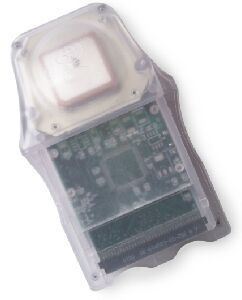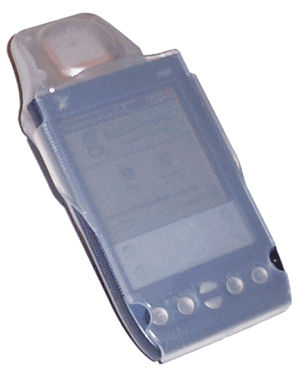 Life isn't
about where you're going, it's all about what you're going to do when you
get there. The Geode GPS module by GeoDiscovery
lets you know there's a small town up ahead, but more importantly it lets
you know what to do while you're there.
Life isn't
about where you're going, it's all about what you're going to do when you
get there. The Geode GPS module by GeoDiscovery
lets you know there's a small town up ahead, but more importantly it lets
you know what to do while you're there.
The Hardware
Here are the specifications for the Geode:
GPS Warm Start: < 8 seconds
GPS Cold Start: < 38 seconds
GPS Initial Location Start: < 45 seconds
Receiver: L1, C/A code
12 Channels
Max. Solution Update Rate: 10 per sec
100 ms Satellite Reacquisition Time
Minimum signal tracked -175dBW
Maximum Altitude < 60,000 feet
Protocols Supported: NMEA** v2.2, SiRF ASCII & Binary
 Now
for the details. The Geode uses a SiRFstar II based GPS receiver
with FoliageLock technology that improves accuracy in areas where GPS signals
can get boxed over rocks, trees, buildings, etc. By using this chip
and the Wide Area Augmentation System (WAAS) of satellites and stations,
the Geode is accurate to within two meters. Click
here for more information on WAAS. And with the digital compass,
you can at least know which way you're facing even when you don't have
a satellite fix.
Now
for the details. The Geode uses a SiRFstar II based GPS receiver
with FoliageLock technology that improves accuracy in areas where GPS signals
can get boxed over rocks, trees, buildings, etc. By using this chip
and the Wide Area Augmentation System (WAAS) of satellites and stations,
the Geode is accurate to within two meters. Click
here for more information on WAAS. And with the digital compass,
you can at least know which way you're facing even when you don't have
a satellite fix.
Included in the Geode package are two AA batteries and a special hard
cover that fits any Visor. The hard cover is clear and slides onto
the front of the Visor, protecting the screen from the elements.
You can still press the Visor's power button and simply slide the cover
down when you need to tap on the Visor's screen. I was surprised
how well the hard "sliding cover" works with the Prism -- inside.
GeoDiscovery needs to make a special Prism version of the cover so that
Prism owners can finally use their Prisms outside. I think people
would even buy one separately just for that reason alone. I know
I would.
That's the packaging of the Geode. The module itself is the most
elegantly designed Springboard module I have ever seen, although somewhat
large. The uniquely domed antenna has the GeoDiscovery logo engraved
into it. The translucent (ice) Geode has contoured edges so that
is comfortable to hold, even though it adds significant weight to the Visor.
The Geode looks like the Starship Enterprise, with its antenna as the "saucer
section" and two MMC slots as the nacelles.
When inserted, there are a few lights that blink on the bottom of the
Geode, adding to its Star Trek look. According to GeoDiscovery, the
bright flash means that the GPS receiver is talking to the DSP (Digital
Signal Processor) and the DSP is talking over the Springboard bus to the
Visor. The dim flash is the DSP performing normal operations.
There are two applications used with the Geode: GeoView
Mobile and Geode Info.
Geode Info Application >>